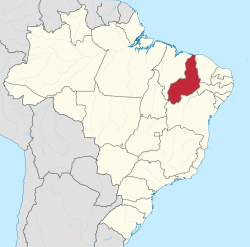Piauí
| State of Piauí | |||
|---|---|---|---|
| State | |||
|
|||
| Motto: Impavidum Ferient Ruinae (Latin) (Wounded and undaunted amid the ruins) |
|||
 Location of State of Piauí in Brazil |
|||
| Coordinates: 8°14′S 43°6′W / 8.233°S 43.100°WCoordinates: 8°14′S 43°6′W / 8.233°S 43.100°W | |||
| Country |
|
||
| Capital and Largest City | Teresina | ||
| Government | |||
| • Governor | Wilson Martins | ||
| • Vice Governor | Moraes Souza Filho | ||
| Area | |||
| • Total | 251,529.186 km2 (97,115.962 sq mi) | ||
| Area rank | 11th | ||
| Population (2012) | |||
| • Total | 3,160,748 | ||
| • Rank | 18th | ||
| • Density | 13/km2 (33/sq mi) | ||
| • Density rank | 18th | ||
| Demonym(s) | Piauiense | ||
| GDP | |||
| • Year | 2006 estimate | ||
| • Total | R$ 12,790,000,000 (23rd) | ||
| • Per capita | R$ 4,213 (27th) | ||
| HDI | |||
| • Year | 2010 | ||
| • Category | 0.646 – medium (25th) | ||
| Time zone | BRT (UTC-3) | ||
| • Summer (DST) | BRT (UTC-3) | ||
| Postal Code | 64000-000 to 64990-000 | ||
| ISO 3166 code | BR-PI | ||
| Website | piaui.pi.gov.br | ||
Piauí (Portuguese pronunciation: [piawˈwi]) is one of the states of Brazil, located in the country's Northeast Region.
Piauí has the shortest coastline of any of the non-landlocked Brazilian states at 66 km (41 mi), and the capital, Teresina, is the only state capital in the northeast to be located inland. The reason for this is, unlike the rest of the area, Piauí was first colonised inland and slowly expanded towards the ocean, rather than the other way around. In the southeast of the state, the National Park of Serra da Capivara is a UNESCO World Heritage Site. The park has more than 400 archaeological sites and the largest concentration of rock paintings in the world, in a landscape dominated by canyons and caatinga.
The state has many notable archaeological sites, including Serra de Capivara National Park and Sete Cidades National Park, which are rich in remains of prehistoric Paleo-Indian and sedentary-based Indigenous Brazilian complex cultures.
Early settlers in the region included Domingos Jorge Velho, from São Paulo state, who brought the first herds of cattle to the area; and Domingos Afonso Mafrense, from Portugal, who founded what is today Oeiras.
In the 17th century, many impoverished noblemen and Jesuit priests, as well as black and Amerindian slaves, settled there. The first large-scale cattle farming also arrived with these settlers. Large estate owners seeking new pastures for their livestock arrived from neighbouring states such as Bahia and Maranhão.
...
Wikipedia


